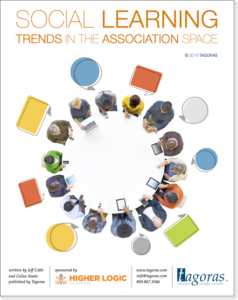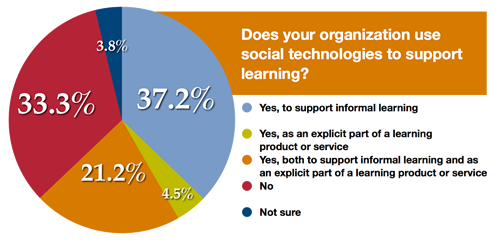Social Learning Trends in the Association Space

Association social learning trends are the focus of this 38-page report. Packed with data and brief case studies on how associations are using social technologies as part of their learning initiatives, Social Learning Trends in the Association Space is available at no charge to anyone who subscribes to the Leading Learning community resource list. Leading Learning is free and high-value, and you’ll get other great resources as a result of subscribing.
To subscribe and get immediate access to the report, simply click the button below.
Social Learning: Definition and Usage
What follows in this section is an excerpt from the beginning of the report.
At the core of this report is a non-statistical online survey of membership organizations for which 159 qualifying responses were received. (For demographic data about the survey respondents’ organizations, see Appendix A. See Appendix B for the raw survey data, parts of which are cited throughout the report.) We offered this definition of social technologies at the beginning of the survey to normalize responses:
For the purposes of this survey, social technologies are any technology that enables users to communicate with each other over the Internet or cellular networks and share text, audio, graphics, video, etc. Popular examples of social technology include, but are not limited to, discussion boards, Twitter, social networks like Facebook and LinkedIn, and private online communities.
Of the 159 responses, 98.1 percent indicated their organization uses social technologies for some purpose. We then asked respondents who use social technologies in general whether they use social technologies for learning. If the organization, for example, has a Twitter account but uses it only for marketing, then that would not be an example of using a social technology for learning.

Only a third (33.3 percent) indicated they did not use social technologies for learning. A bit over a third (37.2 percent) indicated they use social technologies to support informal learning only, a tiny slice (4.5 percent) indicated they use social technologies as an explicit part of a learning product or service only, and approximately a fifth (21.2 percent) indicated they use social technologies both to support informal learning and as an explicit part of a learning product or service.
With 62.9 percent of respondents using social technologies to support some type of learning, it seems clear that not only is the old practice of social learning alive and well, but technology is giving it fresh legs.
Respondents who indicated they use social technologies to support informal learning only were not shown the detailed follow-up questions asked of respondents from organizations using the technologies for formal learning products and services. But they were asked if they have plans to begin using social technologies as an explicit part of a learning product or service in the next 12 months, and, while the majority indicated no, 42.1 percent said yes.
Additional Information
In exploring association social learning we go well beyond just defining it and gauging usage. Here’s the complete table of contents for the report:
- Why Social Learning Matters So Much for Associations
Defining Social Technologies for Learning and Gauging Their Use- On the Use (or Non-Use) of Social Technologies for Learning
- Social Technologies Explicitly As Part of Learning Products or Services
- On Choosing Social Technologies for Learning
- Learning Products and Services Associated with Social Technologies
- Participation in Social Technologies for Learning
- Strategy and Social Technologies for Learning
- Learning Objectives and Social Technologies
- Measurement of Social Technologies’ Support of Learning
- Satisfaction with Use of Social Technologies for Learning
- Success with Use of Social Technologies for Learning
- Social Learning Isn’t a Goal But a Given
- How Online Communities Boost Social Learning: Thoughts from Higher Logic’s Andy Steggles
- Real-World Examples
- CGP Rolls Out Brown-Bag Case-Based Online Groups
- NIGP Focuses on Ease of Use and Motivation in Interactive Courses
- International Foundation Moves Study Groups—and Social Learning Online
- HBA Experiments with Social Technologies Before Homing In
- About Tagoras: Publisher of the Report
- Appendix A: Demographics
- Appendix B: Survey Data
The bottom line is that if association social learning is of interest to you or your organization, this is a report you will not want to miss. Again, Social Learning Trends in the Association Space is available at no charge to anyone who subscribes to the Leading Learning monthly e-newsletter. Leading Learning is free and high-value, and you’ll get other great reports and white papers as a result of subscribing. To subscribe, simply click the button below and look for a confirmation e-mail in your inbox.
Thanks to Our Sponsor
We’re grateful to Higher Logic for sponsoring Social Learning Trends in the Association Space.
Need Help With Social Learning?
If you would like help with leveraging social learning as part of your overall learning business strategy, contact us to set up an exploratory conversation.